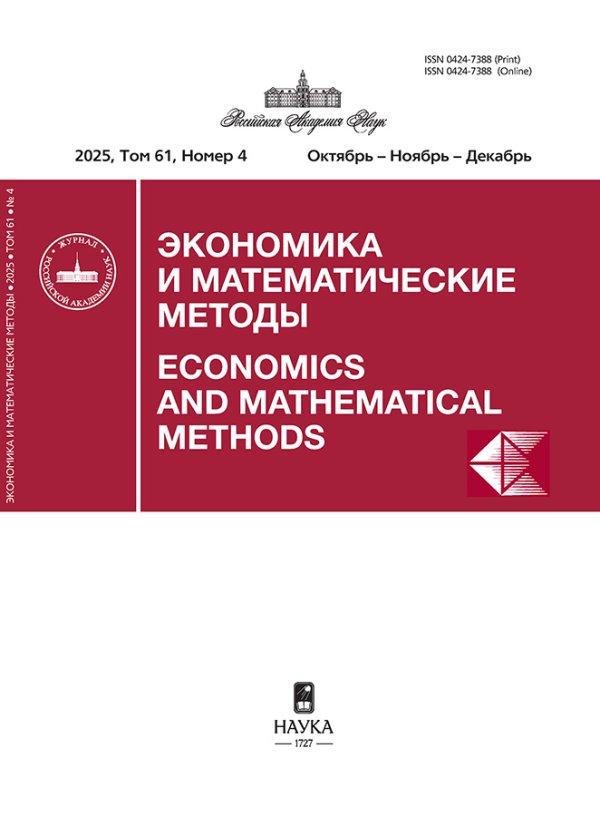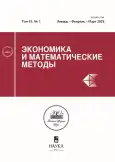Динамическая модель экономического роста с учетом задержек между формированием и использованием человеческого капитала
- Авторы: Кильматов Т.Р.1,2
-
Учреждения:
- мгу им. адмирала Г. И. Невельского
- ДВФУ
- Выпуск: Том 61, № 1 (2025)
- Страницы: 125-128
- Раздел: Математический анализ экономических моделей
- URL: https://vestnik.nvsu.ru/0424-7388/article/view/682167
- DOI: https://doi.org/10.31857/S0424738825010122
- ID: 682167
Цитировать
Полный текст
Аннотация
В рамках макроэкономической динамической модели типа Солоу c учетом накопленного человеческого капитала построена математическая модель, в которой учитывается временна́я задержка между формированием человеческого капитала (время обучения) и его выходом на рынок труда. Предполагается, что участвующий в настоящее время в экономике человеческий капитал сформирован в предшествующее время. Динамическая модель содержит дифференциальное уравнение с отклоняющимся аргументом, имитирующим временные задержки. Построены частные аналитические решения в приближении малого параметра. Анализ решений показывает, что экономический эффект временно́й задержки между формированием и вовлечением в экономику человеческого капитала меняет темпы роста интенсивных параметров экономического агента. Наиболее интересен обсуждаемый фактор по разности воздействия на развитые и развивающиеся страны вследствие их различия по параметрам динамики роста населения и прогресса технологий. Экономические агенты, имеющие опережающие темпы роста численности населения, при прочих равных условиях имеют худшие интенсивные показатели для накопления человеческого капитала. Одновременно, экономические агенты с более высоким уровнем технологий получают преимущество для формирования человеческого капитала. Таким образом, рассматриваемый временно́й эффект может являться дивергентным фактором в темпах технологического развития между развитыми и бедными странами, поскольку в развивающихся странах наблюдается ускоренный рост населения. Одновременно эти страны являются вторичными в разработке новых технологий.
Полный текст
Об авторах
Т. Р. Кильматов
мгу им. адмирала Г. И. Невельского; ДВФУ
Автор, ответственный за переписку.
Email: talgat_k@mail.ru
Россия, Владивосток
Список литературы
- Бекларян Л. А. (2007). Введение в теорию функционально-дифференциальных уравнений. Групповой подход. М.: Факториал Пресс. 288 с. [Beklaryan L. A. (2007). The introduction to the theory of functional differential equations. Group approach. Moscow: Factorial Press. 288 p. (in Russian).]
- Кильматов Т. Р. (2013). Временной лаг как фактор потери устойчивости экономической системы // Экономика и математические методы. Т. 49. № 3. С. 120–122. [Kilmatov T. R. (2013). Time lag and the instability of a business system. Economics and Mathematical Methods, 49, 3, 120–122 (in Russian).]
- Эльсцгольц Л. Э., Норкин С. Б. (1971). Введение в теорию дифференциальных уравнений с отклоняющимся аргументом. М.: Наука. 296 с. [Elscgolc L. E., Norkin S. B. (1971). The introduction to the theory of differential equations with deviating argument. Moscow: Nauka. 296 p. (in Russian).]
- Bellman R. (1949). On the existence and boundedness of solutions differential-difference equations. Annals of Mathematics, 50, 2, 347–355. doi: 10.2307/1969460
- Lucas R. E. (1988). On the mechanics of economic development. Journal of Monetary Economics, 22, 1, 3–42.
- Mankiw G., Romer D., Weil D. (1992). Contribution to the empirics of economic growth. The Quarterly Journal of Economics, 107, 2, 407–437. doi: 10.2307/2118477
- Romer P. (1989). Human capital and growth: Theory and evidence. NBER Working paper, 3173. doi: 10.3386/w3173
- Romer P. (1990). Endogenous technological change. Journal of Political Economy, 98, 5, 71–102.
- Solow R. M. (1956). Contribution to the Theory of Economic Growth. The Quarterly Journal of Economics, 70, 1, 65–94.
Дополнительные файлы








